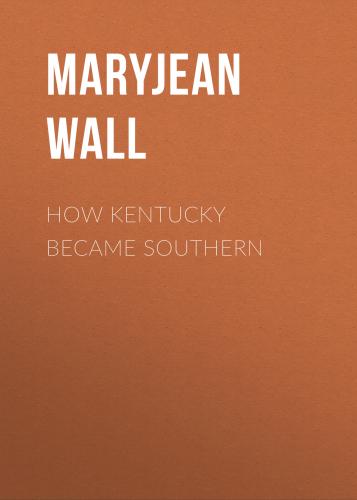HOW
KENTUCKY
BECAME
SOUTHERN
a tale of OUTLAWS, HORSE THIEVES, GAMBLERS, and BREEDERS
Maryjean Wall
Copyright © 2010 by The University Press of Kentucky
Scholarly publisher for the Commonwealth, serving Bellarmine University, Berea College, Centre College of Kentucky, Eastern Kentucky University, The Filson Historical Society, Georgetown College, Kentucky Historical Society, Kentucky State University, Morehead State University, Murray State University, Northern Kentucky University, Transylvania University, University of Kentucky, University of Louisville, and Western Kentucky University. All rights reserved.
Editorial and Sales Offices: The University Press of Kentucky 663 South Limestone Street, Lexington, Kentucky 40508-4008 www.kentuckypress.com
14 13 12 11 10 5 4 3 2 1
Library of Congress Cataloging-in-Publication Data
Wall, Maryjean.
How Kentucky became southern: a tale of outlaws, horse thieves, gamblers, and breeders/Maryjean Wall.
p. cm.
Includes bibliographical references and index.
ISBN 978-0-813-12605-0 (hardcover: alk. paper)
1. Horse racing—Kentucky—History—19th century. 2. Horse industry—Kentucky—History—19th century. 3. Kentucky—Social life and customs—19th century. I. Title.
SF335.U6K66 2010
798.409769’09034—dc22
2010020664
This book is printed on acid-free recycled paper meeting the requirements of the American National Standard for Permanence in Paper for Printed Library Materials.
Manufactured in the United States of America.
To my parents,
John and Mary Wall,
who believed in education
Contents
1. The Fast Track into the Future
2. The Greening of the Bluegrass
3. A Killing Spree and a Hanging Tree
4. “All the Best Jockeys of the West Are Colored”
5. Old Money Meets the Arrivistes
6. Winners and Losers in the Age of Reform
7. The Idea of Horse Country Reclaimed
The Kentucky colonel is often associated with the traditions and history of Thoroughbred racing in Kentucky. (1917 postcard from the author’s collection.)
Introduction
Kentucky, racehorses, and Southern colonels just seem to go together naturally. Whether picturing Bluegrass horse farms or their close relative, the Kentucky Derby, many of us cannot summon one of those images without calling up all three. The goateed colonel holds the dominant position in the landscape of imagination that defines this central portion of Kentucky. Place the colonel on the colonnaded plaza of a grand mansion, surround him with guests and family sipping juleps served on silver trays, indulge him in his telling of tall tales about fast horses, and the image evokes Kentucky horse country.
This picture has been stamped so indelibly on notions of Bluegrass Thoroughbred culture that not even Kentuckians seem aware that horse country did not historically fit this image. To borrow a phrase from Michael Kammen, who argues that memory is reconstructed as history, the “mystic chords of memory” have failed to serve Bluegrass history in any faithful way. True, the mineral-rich soil, water, and bluegrass, the latter known scientifically as Poa pratensis, did spawn a significant racehorse business during the antebellum period. However, this business as it stood in Kentucky rocked precariously on the edge of decline during the first forty or fifty postbellum years. True, Thoroughbred horse racing experienced an explosive growth in popularity during this era. However, at the same time, Kentucky lost its dominant position as the locus for the breeding of racehorses. Modern new farms were arising in New Jersey and New York, fragmenting the business among multiple states.1
A generation would pass before Bluegrass Kentuckians managed to return the center of the Thoroughbred breeding world to their region. This mattered greatly to them, primarily because of the direct and residual income that a Bluegrass-centered industry could bring to the state. We all know how the story turned out: that horse breeding became the commonwealth’s signature agricultural industry, bringing worldwide respect and recognition to the state. Today, the Kentucky horse industry has an economic impact that is estimated to be $4 billion, not to mention the $8.8 billion in associated tourism that it brings in. Had the story turned out differently, the commonwealth might never have realized the wealth in modern times that horses have brought to it. The victory was hard-won.2
Many are unaware that, for decades, Kentucky horsemen engaged in a power struggle with the new money in the sport—those industrialists and capitalists of New York who were spending money at unprecedented levels to develop horse farms in the Northeast. The architecture and design of these new horse-breeding operations in New Jersey and New York outshone anything existent in Kentucky, even the famed Woodburn Farm. The latter, a premier breeding operation located in Woodford County and known throughout the United States even before the Civil War, stood the leading stallions in the United States at stud. However, Woodburn Farm could not boast of the fancy appointments of these nouveau racehorse operations rising in the Northeast. The agricultural wealth of Kentuckians simply could not compete with the vast array of industrial wealth in the Northeast. Only one among Kentucky’s horse breeders, Robert Aitcheson Alexander, who owned Woodburn Farm, possessed a fortune founded in industry. The numerous industrialists from the Northeast who were getting into the sport outnumbered him. And it was to the Northeast that the center of the sport had swung, with the new men of the turf breeding their own mares to their own stallions far removed from traditional horse country.
Permanent loss of this business would have affected the Bluegrass region in myriad ways, beginning with the physical
